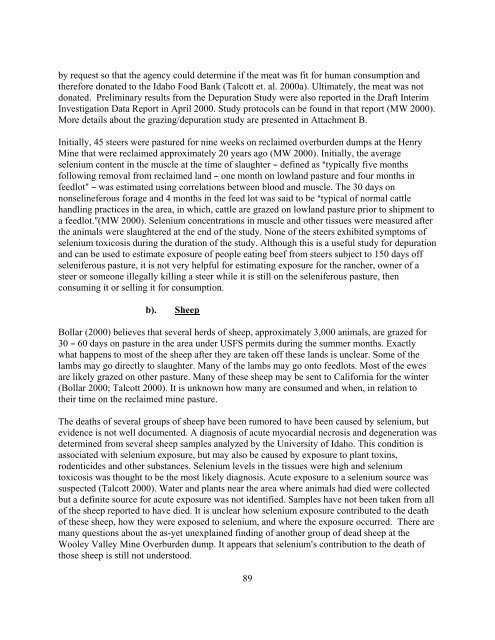Southeast Idaho Phosphate Mining Resource Area - Agency for ...
Southeast Idaho Phosphate Mining Resource Area - Agency for ...
Southeast Idaho Phosphate Mining Resource Area - Agency for ...
Create successful ePaper yourself
Turn your PDF publications into a flip-book with our unique Google optimized e-Paper software.
y request so that the agency could determine if the meat was fit <strong>for</strong> human consumption and<br />
there<strong>for</strong>e donated to the <strong>Idaho</strong> Food Bank (Talcott et. al. 2000a). Ultimately, the meat was not<br />
donated. Preliminary results from the Depuration Study were also reported in the Draft Interim<br />
Investigation Data Report in April 2000. Study protocols can be found in that report (MW 2000).<br />
More details about the grazing/depuration study are presented in Attachment B.<br />
Initially, 45 steers were pastured <strong>for</strong> nine weeks on reclaimed overburden dumps at the Henry<br />
Mine that were reclaimed approximately 20 years ago (MW 2000). Initially, the average<br />
selenium content in the muscle at the time of slaughter B defined as Atypically five months<br />
following removal from reclaimed land B one month on lowland pasture and four months in<br />
feedlot@ B was estimated using correlations between blood and muscle. The 30 days on<br />
nonselineferous <strong>for</strong>age and 4 months in the feed lot was said to be Atypical of normal cattle<br />
handling practices in the area, in which, cattle are grazed on lowland pasture prior to shipment to<br />
a feedlot.@(MW 2000). Selenium concentrations in muscle and other tissues were measured after<br />
the animals were slaughtered at the end of the study. None of the steers exhibited symptoms of<br />
selenium toxicosis during the duration of the study. Although this is a useful study <strong>for</strong> depuration<br />
and can be used to estimate exposure of people eating beef from steers subject to 150 days off<br />
seleniferous pasture, it is not very helpful <strong>for</strong> estimating exposure <strong>for</strong> the rancher, owner of a<br />
steer or someone illegally killing a steer while it is still on the seleniferous pasture, then<br />
consuming it or selling it <strong>for</strong> consumption.<br />
b).<br />
Sheep<br />
Bollar (2000) believes that several herds of sheep, approximately 3,000 animals, are grazed <strong>for</strong><br />
30 B 60 days on pasture in the area under USFS permits during the summer months. Exactly<br />
what happens to most of the sheep after they are taken off these lands is unclear. Some of the<br />
lambs may go directly to slaughter. Many of the lambs may go onto feedlots. Most of the ewes<br />
are likely grazed on other pasture. Many of these sheep may be sent to Cali<strong>for</strong>nia <strong>for</strong> the winter<br />
(Bollar 2000; Talcott 2000). It is unknown how many are consumed and when, in relation to<br />
their time on the reclaimed mine pasture.<br />
The deaths of several groups of sheep have been rumored to have been caused by selenium, but<br />
evidence is not well documented. A diagnosis of acute myocardial necrosis and degeneration was<br />
determined from several sheep samples analyzed by the University of <strong>Idaho</strong>. This condition is<br />
associated with selenium exposure, but may also be caused by exposure to plant toxins,<br />
rodenticides and other substances. Selenium levels in the tissues were high and selenium<br />
toxicosis was thought to be the most likely diagnosis. Acute exposure to a selenium source was<br />
suspected (Talcott 2000). Water and plants near the area where animals had died were collected<br />
but a definite source <strong>for</strong> acute exposure was not identified. Samples have not been taken from all<br />
of the sheep reported to have died. It is unclear how selenium exposure contributed to the death<br />
of these sheep, how they were exposed to selenium, and where the exposure occurred. There are<br />
many questions about the as-yet unexplained finding of another group of dead sheep at the<br />
Wooley Valley Mine Overburden dump. It appears that selenium=s contribution to the death of<br />
those sheep is still not understood.<br />
89
















